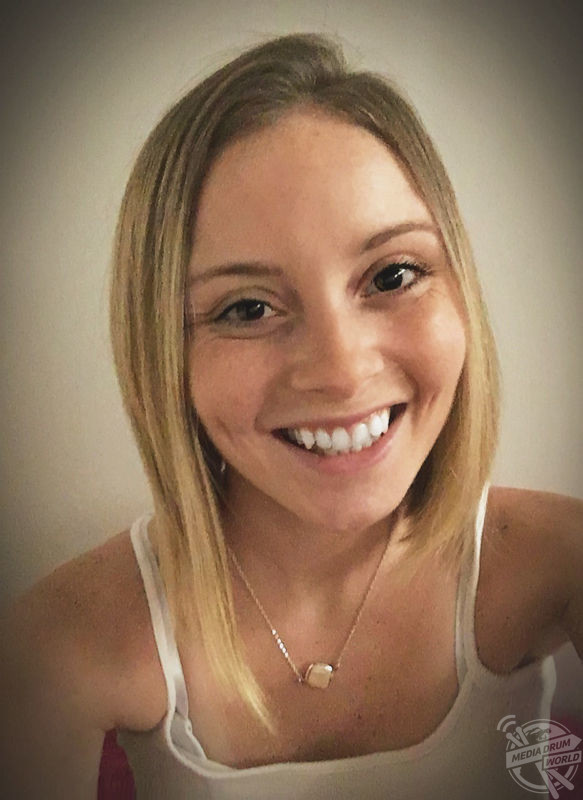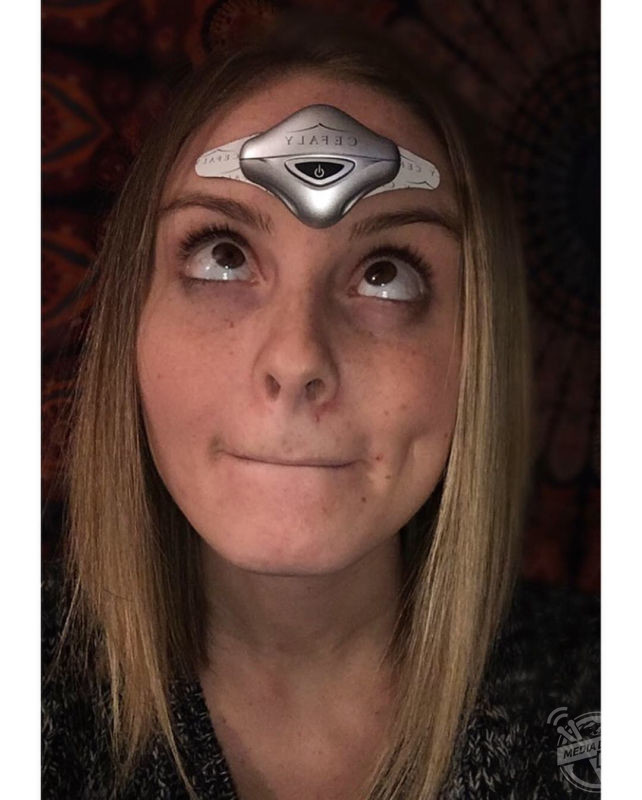By Rebecca Drew
THIS WOMAN has had to learn to walk, talk, read and write again after suffering a traumatic brain injury when the car she was driving slid on ice and crashed into a telephone pole leading to her head slamming into her steering wheel at 30mph – but it took doctors FOUR MONTHS to admit her to a rehab facility after initially believing she was FINE and DISCHARGING her the NEXT DAY.
On January 24, 2017, rehab therapist, Kaitlyn McInerney (24) from Albany, New York, USA, was on her way to work at her new job where she was excited to be working on the hospital floor on her own for the first time. As she was new to the hospital, Kaitlyn didn’t yet have a parking permit so had been parking on the streets nearby. It had been snowing overnight and the roads were slippery, as Kaitlyn turned down a side road to park, her car spun on the ice and crashed into a telephone pole, her airbags failed, and her head slammed into her steering wheel at a speed of 30mph.

Kaitlyn describes the aftermath of the accident as ‘an outer body experience’ as she was aware of everything going on around her but was dazed and unable to articulate how she was feeling to the paramedics who rushed to the scene. Kaitlyn was in hospital for just one day following the accident after doctors took CT scans and x-rays, and told her she had severe concussion and whiplash and the reason she was unable to speak was due to her suffering from PTSD after hitting her head and it would come back on its own.
It took Kaitlyn four months before she was admitted to a rehabilitation facility as at home she was suffering from severe headaches, dizziness, nausea, sensitivity to light and sound, and was still struggling to talk, walk, read and write. In May 2017, she was diagnosed with a traumatic brain injury (TBI), post-concussive syndrome, aphasia, photophobia, pseudo seizures and migraines.
Since being in rehab, Kaitlyn has learnt how to walk, talk, read, write and even eat again with the help of occupational, physical, vision and light and speech therapies. Kaitlyn found it hard to adjust to the ‘new’ her and when she found therapy difficult would mourn the person she once was but credits her mum, Lynda, for supporting her and being a positive influence in her recovery and now she refuses to be seen as a victim.

“I remember the morning of my car accident like it was yesterday. Sometimes I have dreams and nightmares that replay the entire thing for me. Whenever it snows out, I have the worst anxiety and refuse to leave my house or even get in a car,” said Kaitlyn.
“We had a bad snowstorm that started the night before that continued into the morning. I was on my way to work at my new job, where I had just finished my training and was officially going to be working on the hospital floor on my own for the first time. I didn’t have a parking pass to park in the garage yet, so I was stuck trying to find a spot on the street somewhere close to the hospital.
“I went to turn down a side road, I was only going 30mph if that. My car slid on ice and I lost control of my vehicle. I crashed into a telephone pole and completely totalled my car. Unfortunately, my airbags never went off, and my head slammed right into my steering wheel.
“I remember being awake and aware of everyone that was around me. I remember seeing and hearing the firemen and EMT guys around me. So many people were talking to me all at once, asking a million questions. It was as if I was awake but asleep.

“I couldn’t get a single word out. I tried so hard to scream or make some type of noise – anything. But all I could do was sit there in silence. I was stuck in a daze as they pulled me out of my car and put me on the gurney and into the ambulance.
“I could comprehend and understand everything that was being said and happening around me. It felt like an out of body experience, because I myself just couldn’t communicate what I was feeling or thinking or needed or wanted.
“I was only in the hospital for one day, the same day that the accident happened, I was diagnosed with a severe concussion and whiplash. They discharged me after they took x-rays and a CT scan. The doctors told me that the reason I was unable to speak was due to the PTSD of the whole situation and from hitting my head. They said it should come back on its own and sent me home.
“It took four months to get me into the rehab facility that I needed for treatment. My paediatrician had to fight for me to get the help that I needed because other physicians believed I was fine. Once I was able to get an appointment, I received occupational therapy, physical therapy, vision and light therapy, and speech therapy. I had to learn how to speak, walk, eat, read and write.

“Even though they told me I was going to be fine leaving the hospital that day, I knew I had a long road ahead of me. I knew what I was experiencing and feeling wasn’t normal. The severe headache, extreme dizziness and nausea, and sensitivity to light and sound. And sitting at home not getting treatment or help for months was just adding to the pain.
“When I was finally accepted as a patient at the rehab centre, I knew after my first day being there that it was going to be tough. Realising that the things that used to come so easily to me, things that I used to take for granted, I couldn’t do at all, that was the worst. That hurt the most. Because I could try to do these tasks a million times and I’d still fail- continuously.
“I mean imagine what that feels like when you’re in the right mind, now imagine what it feels like when you’re in a broken one. It’s pretty messed up. Your patience is extremely thin, every little thing irritates you, you hate the people around you for being able to do the things you can’t even though it’s not their fault that you’re hurt. You take your anger out on the ones that are just trying to help you. You use your family as a punching bag.”
For Kaitlyn, the most difficult thing about her recovery has been mourning the loss of the person she used to be, but she is now working with her brain instead of against it to become a warrior of her circumstances and refuses to be seen as a victim.
“I think the hardest part of this recovery is grieving the loss of the person I was, while still being alive. There are times when you don’t know yourself. There are times when you don’t want to know yourself. There are times when you want to be who you were prior,” said Kaitlyn.
“This brain doesn’t work like the old one, but I can learn to navigate with it. I found that my “broken” brain has a different set of abilities. I made the decision to work with my brain instead of against it. I’m looking forward to the day that I choose to greet the new me.
“I have suffered with poor speech, memory loss, inability to read and write and seizures. I have battled chronic pain, depression, anxiety, PTSD, loneliness, lost hope, friendships ruined, my studies put on hold, exercise intolerance, and countless doubts in the goodness of God.

“For a long time, I thought I was scared to step out as a person with a disability, but the truth is I just wasn’t ready. Two years ago, God made this decision for me, and I’m finally choosing it for myself. I don’t want my pain and struggle to make me a victim. I want my battle to make me a warrior.
“I’ve started to share my story because my healing process has been far from easy, and continues to be emotional, scary, sad, ugly, and everything in between. I have become a volunteer and advocate for the Brain Injury Association of Albany.
“I want to be part of the prevention and outreach campaign, enhance public knowledge and educate health care providers as well as the community, along with where they can find and access treatment, rehabilitation and support services, no matter what they may be diagnosed with or battling.
“I’ve just recently started a job as a rehab therapist at Sunnyview, working on the brain and spinal cord injury floor. It’s ironic to me that I get to work and be a patient at the same place that saved my life, where I get to help people that are like me- who suffer from a traumatic brain injury that has changed their life forever.
“I get to give back to this community of survivors in ways that I never thought I’d be able to. I get to use my personal experience and ongoing recovery story to hopefully inspire others.”

Finally, Kaitlyn shared her words of advice to others who might have found themselves in similar circumstances as her.
“My advice for anyone who is dealing with a traumatic brain injury, or chronic illnesses, or invisible disabilities is, do not feel like you need to wait until you are one hundred per cent healthy before you can start to live your life, because you will be waiting forever,” she said.
“Whatever you have, it’s a diagnosis, not a disgrace. Do not be ashamed or embarrassed. You see, I hit rock bottom but I had the opportunity to rebuild myself. I look at myself as a kaleidoscope, I’m a structure that’s filled with broken bits and pieces, and somehow if you look at me and really focus, you see something beautiful.
“Some of those pieces are from my past, the old me. Some are from the new me. Sometimes I’m okay with it, and other times I’m not. I take pride in my pain, because I know I am stronger than those who have none. You should too. Be the hero of your own story.”







